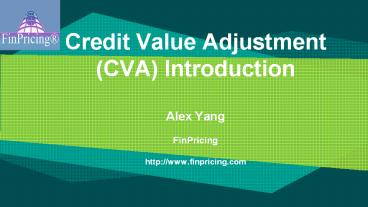Credit Value Adjustment (CVA) Introduction PowerPoint PPT Presentation
Title: Credit Value Adjustment (CVA) Introduction
1
Credit Value Adjustment (CVA) IntroductionAlex
YangFinPricinghttp//www.finpricing.com
2
CVA Introduction
- Summary
- CVA History
- CVA Definition
- Risk Free Valuation
- Risky Valuation
http//www.finpricing.com/lib/cva.pptx
3
CVA Introduction
- CVA History
- Current market practice
- Discounting using the LIBOR or risk-free curves
- Using risk-free value for pricing, hedging, PL
- Real counterparty reality
- Having different credit qualities from LIBOR
- Having risk of default
- ISA 39 (International Accounting Standard)
- Requiring CVA in 2000 (mandatory)
- Finance and Accounting owning CVA
- Receiving a little attention in the beginning
- Becoming significant risk after financial crises
http//www.finpricing.com/lib/cva.pptx
4
CVA Introduction
- CVA Definition
- Definition
- CVA Risk free value True (risky) value
- Benefits
- Quantifying counterparty risk as a single PL
number - Dynamically managing, pricing, and hedging
counterparty risk - Notes
- CVA is a topic of valuation and requires accurate
pricing and risk-neutral measure - Risk-free valuation is what we use every day.
Risky valuation is less explored and less
transparent
http//www.finpricing.com/lib/cva.pptx
5
CVA Introduction
- Risk-Free Valuation
- The risk-free valuation is what brokers quote or
what trading systems or models normally report. - A simple example to illustrate
- A zero coupon bond paying X at T
- The risk-free value
- where r is risk-free interest rate and
- is risk-free discount factor
http//www.finpricing.com/lib/cva.pptx
6
CVA Introduction
- Risky Valuation
- Default Modeling
- Structural models
- Studying default based on capital structure of a
firm - Reduced form models
- Characterizing default as a jump (Poisson)
process - Market practitioners prefer the reduced form
models due to - Mathematical tractability
- Consistency with market observations as
risk-neutral default probabilities can be backed
out from bond prices and CDS spreads
http//www.finpricing.com/lib/cva.pptx
7
CVA Introduction
- Risky Valuation (Continuously Defaultable)
- The same simple example a zero coupon bond
paying X at T - The risk value
- where
- r is risk-free interest rate and s is credit
spread - is risk adjusted discounting
factor - CVA by defintion
http//www.finpricing.com/lib/cva.pptx
8
CVA Introduction
http//www.finpricing.com/lib/cva.pptx
9
Thanks!
- You can find more online presentations at
- http//www.finpricing.com/paperList.html

